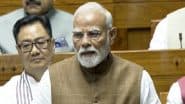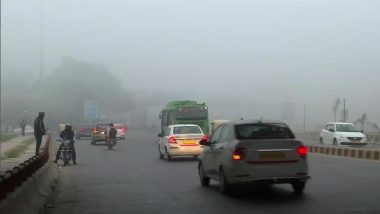New Delhi, January 4: Delhi's minimum temperature on Wednesday morning plunged to 4.4 degrees Celsius -– the season's lowest -- making the national capital colder than Dharamsala, Nainital and Dehradun. A dense layer of fog lowered visibility to 200 metres, affecting the movement of road and rail traffic.
At least 19 trains to Delhi were delayed by one-and-a-half to four-and-a-half hours due to the foggy weather, a Railways spokesperson said. The India Meteorological Department (IMD) shared satellite images that showed a thick layer of fog over the Indo-Gangetic plains and adjoining central and eastern parts of the country.
The Palam observatory at the Indira Gandhi International Airport logged a visibility level of 200 metres at 5.30 am. According to the weather office, 'very dense' fog is when visibility is between 0 and 50 metres, 51 and 200 metres is 'dense', 201 and 500 metres 'moderate', and 501 and 1,000 metres 'shallow'. Delhi Weather Update: Dense Fog Envelopes National Capital; Temperature Drops to Season’s Lowest of 4.4 Degrees Celsius.
With frosty winds from the snow-clad Himalayas barrelling through the plains, the Safdarjung observatory, Delhi's primary weather station, saw the minimum temperature plummet to 4.4 degrees Celsius from 8.5 degrees a day ago. Delhi's minimum temperature was lower than that of Dharamsala (5.2 degrees), Nainital (6 degrees) and Dehradun (4.5 degrees).
The Delhi Ridge weather station near Delhi University recorded a cold wave with a minimum temperature of 3.3 degrees Celsius, the lowest in the capital on Wednesday.
"A cold wave is prevailing in Delhi and maximum temperatures are also low, leading to cold day conditions. Most places are likely to record maximum temperatures between 13 degrees and 15 degrees Celsius," Senior IMD Scientist RK Jenamani said. However, there has been an improvement in Delhi's fog condition, he said.
"Cold wave and cold day conditions are predicted to continue for the next 24 to 48 hours though there will be some improvement under the influence of a fresh Western Disturbance, which is likely to affect northwest India starting January 7," Jenamani said.
The senior meteorologist said similar conditions persist across north India, including Punjab, Haryana, Rajasthan, Uttar Pradesh and Bihar. Day temperatures in these states are likely to remain much below normal. Cold day and severe cold day conditions are predicted to wallop Uttar Pradesh.
Maximum temperatures in the state will remain 10 to 12 degrees Celsius below normal, the IMD official said. North Rajasthan is reeling under severe cold wave conditions, with Churu recording a minimum temperature of minus 0.9 degrees Celsius. Delhi Air Pollution: Experts Warn of Respiratory Issues As Toxic Levels Rise in Air Due to Fog.
The Met office has issued a red alert for Uttar Pradesh for Wednesday and Punjab and Haryana for Wednesday and Thursday. An orange alert has been issued for Delhi-NCR for the next two days. The IMD uses four colour codes for weather warnings -- green (no action needed), yellow (watch and stay updated), orange (be prepared) and red (take action).
The cold snap is expected to strain power grids and pose challenges to homeless people. 'Cold day' conditions had gripped Delhi on Tuesday with the maximum temperature dropping five degrees below normal at many places in the national capital, including Lodhi Road, Palam, Jafarpur and Mayur Vihar.
A cold day is when the minimum temperature is less than or equal to 10 degrees Celsius below the normal and the maximum temperature is at least 4.5 degrees Celsius below the normal. A severe cold day is when the maximum is 6.5 degrees Celsius or more below the normal.
The IMD has predicted dense to very dense fog and cold day conditions over northwest India during the next four to five days. Coldwave conditions are likely to continue over northwest India during the next two days and the intensity will decrease thereafter, it said.
In the plains, the Met office declares a cold wave if the minimum temperature dips to four degrees Celsius or when the minimum temperature is 10 degrees Celsius or below and is 4.5 notches below normal. A severe cold wave is when the minimum temperature dips to two degrees Celsius or the departure from the normal is more than 6.4 degrees Celsius.













 Quickly
Quickly












